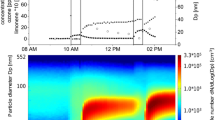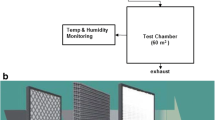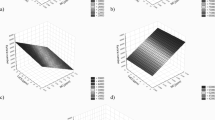The effect of the increase in relative humidity on the change in the number concentration of fine airborne particles in a closed sealed chamber is studied in the paper. This work was carried out within the scope of a series of works of the SIRIUS international project. The project is aimed at studying the dynamics of aerosol accumulation in the air environment of sealed inhabited objects using methods for assessing the level of aerosol contamination worked out in cleanroom technology. A qualitative result of the relationship between the number concentration of the airborne particles and the relative humidity inside the closed chamber in the absence of other sources of particle generation was obtained. This result correlates with the experimental data obtained during the SIRIUS four-month isolation experiment and lays the foundation for preparing for new isolation experiments of the SIRIUS project.
Similar content being viewed by others
References
Official website of the international project SIRIUS http://sirius.imbp.info/.
G. S. Oxborrow, N. D. Fields, and J. R. Puleo, C. M. Herring, Health Lab. Sci., 12 (1), 47−51 (1975).
B. Ljungqvist and B. Reinmüller, PDA J. Pharmaceutic. Sci. Technol., 54 (2), 112−116 (2000).
C. S. De Abreu, T. J.A. Pinto, and D. C. De Oliveira, PDA J. Pharmaceutic. Sci. Technol., 58 (1), 45−53 (2004).
Jay S. Raval, Eileen Koch, and Albert D. Donnenberg, Cytotherapy, 14, 1144−1150 (2012). https://doi.org/10.3109/14653249.2012.698728.
P. A. Aleksandrov, V. I. Kalechits, I. E. Kovbasyuk, et al., Chist. Pomeshch. Tekhnolog. Sredy, No. 6, 6−12 (2019).
P. A. Aleksandrov, A. V. Aleksandrova, E. A. Antonov, et al., Bioteknolog., No. 6, 138−148 (2020). https://doi.org/10.21519/0234-2758-2020-36-6-138-148.
GOST 30494-2011. Public and Residential Buildings. Parameters of Microclimate in Premises [in Russian], Standartinform, Moscow (2011).
GOST R ISO 14644-1-2017. Clean Rooms and Related Controlled Environments. Part 1. Classification of Air Purity by Particle Concentration [in Russian], Standartinform, Moscow (2017).
V. Z. Aksel-Rubinstein, Sanitary Chemistry of the Atmosphere of Sealed Facilities [in Russian], St. Petersburg (2010).
Author information
Authors and Affiliations
Corresponding author
Additional information
Translated from Izvestiya Vysshikh Uchebnykh Zavedenii, Fizika, No. 3, pp. 97–104, March, 2022.
Rights and permissions
Springer Nature or its licensor holds exclusive rights to this article under a publishing agreement with the author(s) or other rightsholder(s); author self-archiving of the accepted manuscript version of this article is solely governed by the terms of such publishing agreement and applicable law.
About this article
Cite this article
Kovbasyuk, I.E., Maslakov, O.Y., Paramonov, A.M. et al. Effect of Relative Air Humidity on the Number Concentration of Aerosol Particles in a Sealed Volume. Russ Phys J 65, 499–506 (2022). https://doi.org/10.1007/s11182-022-02661-x
Received:
Accepted:
Published:
Issue Date:
DOI: https://doi.org/10.1007/s11182-022-02661-x




